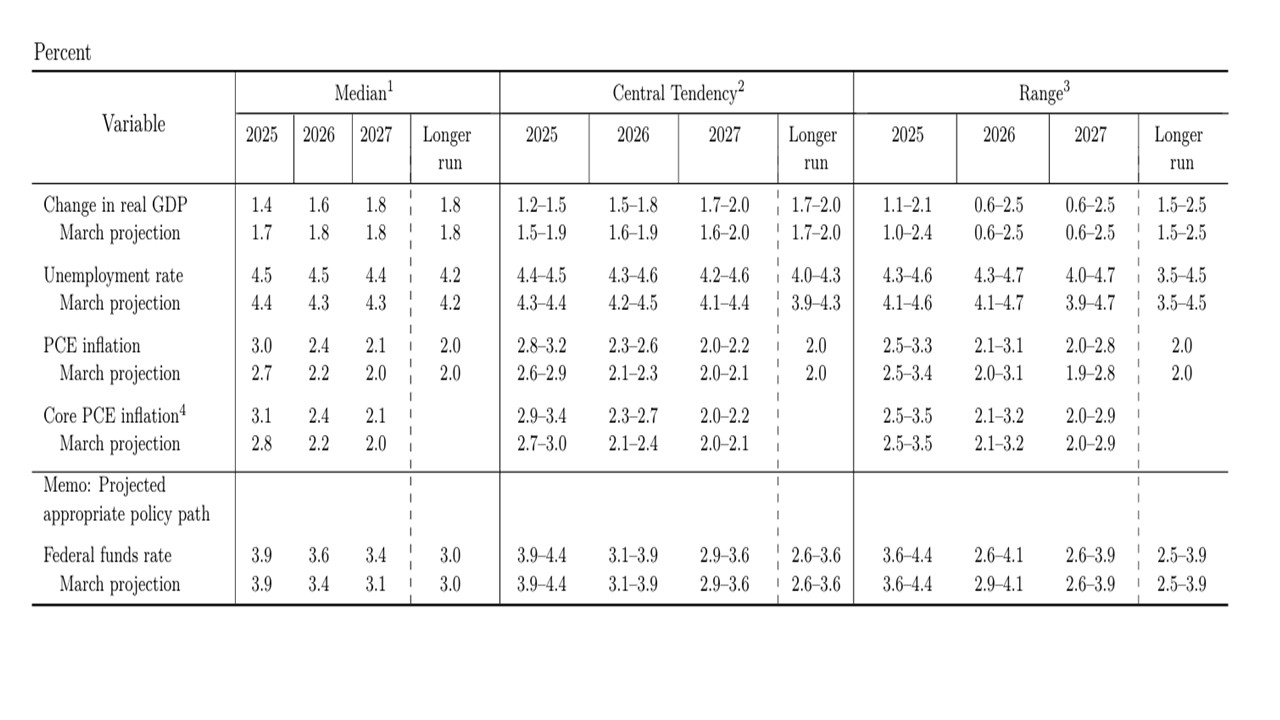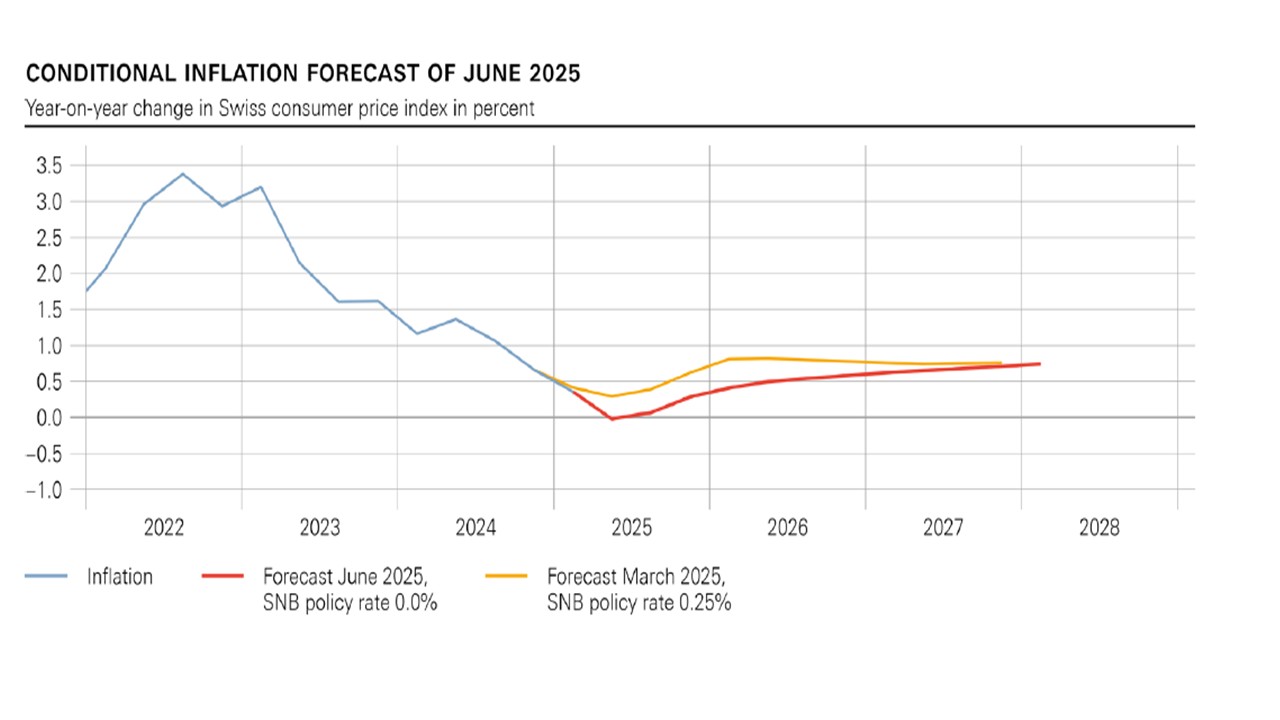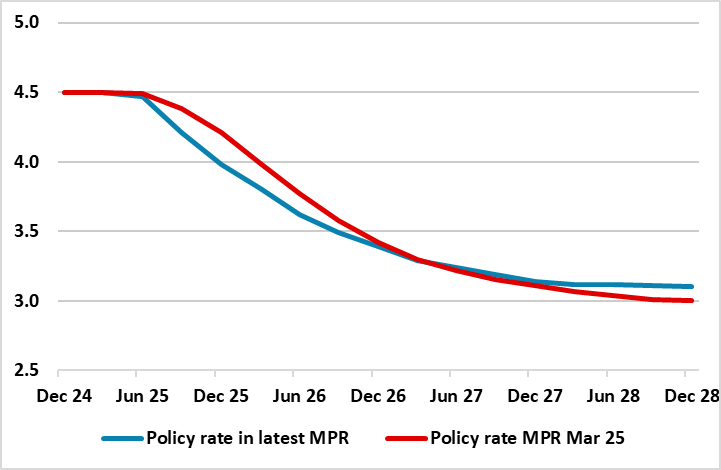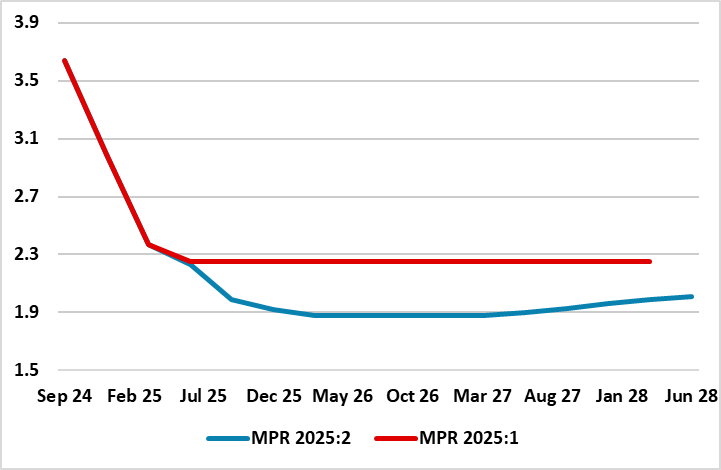This week's five highlights
Fed Hold Then Cautious Easing
Labour Market Softness Triggers a Dovish BoE Hold
SNB Cut to Zero, But Negative Rates an Option
Norges Bank Coming (Very) Late to the Party
Riksbank Cuts and Flags Possible Further Move
Figure: Fed June Summary of Economic Projections (SEP)

Though the SEP reduced growth forecasts and boosted inflation, the guidance from the Fed remains that policy is on hold in the coming meetings. Though the FOMC median still has two 2025 cuts, the breakdown shows that this was a close call and a lot of members see no cut or only 25bps. We look for a 25bps Q4 cut and then three 25bps cuts in Q2-Q4 before the Fed delivers one final cut in 2027.
The June FOMC statement and Fed Chair Powell Q/A provide a number of clues on prospective policy. Key points include
· Inflation and growth uncertainties. The SEP (Figure 1) saw the net tariff effect of the last 3 months since March boost core CPI projections for 2025-26 and reduce GDP for the same two years. This is measured rather than aggressive in nature on both GDP and inflation. The 2.4% median projection for 2026 core PCE inflation would also still represent progress towards target, but also crucially FOMC officials view that the tariff inflation effect will largely be 1 round effects and not persist. The FOMC statement also noted that uncertainty about the economy had diminished but remains elevated. We agree with this, as the Trump administration actions have been curtailed by markets and supply chain concerns and we see the end average tariffs rate being 13-15% (here). Fed chair Powell echoed this view as well in the Q/A.
· Guidance on Interest rates. The SEP medians still show two 25bps rate cuts for 2025, but 2026 has been trimmed to one 25bps cut. The breakdown of the FOMC members view shows that 7 out of 19 see no cut this year from the current 4.25-4.50% and for 2026 the split show two major groups at 3.75-4.00% and 3.25-3.50% -- with the 2026 median happening to be in between. This underlines that the FOMC members have diverging views for 2025 and 2026 and that the median of two cuts for 2025 is not high confidence. Fed Powell also tried to temper the 2026 and 2027 Fed Funds medians and focus more on 2025. Powell during the Q/A was reluctant to be drawn on hints on timing and once again showed a patience on maintaining current policy rates.
· 2025/26 rate prospects. The Fed is not sufficiently worried about the economy at the moment to overlook what it anticipates will be a temporary boost to inflation. This argues for policy to remain on hold in the coming meetings in July and September, unless the real sector data deteriorates sharply. October is possible, but we still prefer a 25bps cut at the December meeting. After a solitary move in Q4 2025, we expect the Fed to pause in Q1 2026 before delivering 25bps moves in Q2, Q3 and Q4. This reflects our view that core PCE inflation will move towards target, with the Fed likely to focus on monthly changes into the winter and spring. Additionally, we see easing driven by the desire to get growth back up towards trend. That would leave the upper bound of the Fed Funds target range at 3.5% at the end of 2026, still slightly above the 3.0% that the Fed currently sees as neutral. We suspect that in a less globalized word, the long-term neutral rate will edge slightly above 3.0%.
Figure: BoE Rate Cuts To Date Have Not Stopped Financial Conditions Tightening

A stable BoE policy decision was always the most likely (Bank Rate staying at 4.25%) as the MPC discussed its two alternative scenarios still, but possibly where hawks have been forced into diluting what were previous concerns about a ‘tight’ labor market. In fact, partly based on what was seen as a ‘material further loosening in labour market conditions’, Dep Governor Ramsden (as he did twice in 2024) dissented in favor of a 25 bp rate cut, thereby adding to the more longstanding such demands from his colleagues Taylor and Dhingra. Regardless, the Monetary Policy Statement still repeated the need for policy to be framed carefully as well as gradually, also repeating that monetary policy will need to continue to remain restrictive for sufficiently long – the question being whether the dissenters also reject this line of thinking. But the issue of what constitutes restriction is also important (Figure shows the policy rate diverging from financial conditions) as it should help determine how much further and when the BoE eases.
We think that with the BoE regarding neutral policy rate as being well above 3%, two further 25 bp moves this year will be followed by another 50 bp in H1 2026. But we think the risks are for deeper and possibly faster cuts as we think the BoE is both over optimistic about growth prospects and over-estimating policy neutrality. One question here is if the BoE slows its QT program will this have any bearing on conventional policy; NB – we think that the MPC in September will likely accept that to avoid impacting the monetary transmission mechanism that annual rundown of gilts needs to be slowed from GBP 100bln pa to GBP 75bln. Internal differences within the MPC argue against a more aggressive slowing.
Figure: SNB CPI Inflation Projections

The SNB would probably prefer to consolidate the effects of previous rate cuts, but the low inflation forecast and downside risk to inflation means that a cut to -0.25% is feasible at the September or December meetings. The SNB will also hope that the threat of negative rates restrains the CHF strength and encourages banks to lend, though the FX market is more focused on USD momentum rather than a further rate cut threat.
As expected the SNB cut the policy rate from 0.25% to zero at the June meeting. Key points to note
· Inflation forecast. The short-term inflation forecast was trimmed, given the recent soft CPI inflation outcomes. GDP forecasts for 2025 and 2026 at 1.0-1.5% are consistent with market thinking. Though the medium-term forecasts were hardly changed (Figure 1), they still remain low with 2027 inflation at 0.7%. The SNB statement noted that these are consistent with price stability, but the SNB has been cutting with inflation forecasts this low. The SNB thus could have to cut back into negative territory and SNB officials will likely make clear that this is an option.
· Disinflation threat and negative rates. The SNB faces a three pronged disinflationary threat from tariffs imposed by the U.S., strong CHF and domestic disinflation. These all produce threats to the downside for the inflation forecast. The U.S. is likely to impose a 25% tariff on pharmaceuticals in the coming months, which would further hit Swiss exports and production. The USD is in a multi-year downtrend, with the CHF being one of the leading edges of the move. Finally, domestic inflation pressure is subdued, with domestic credit growth soft and consistent with low inflation (Figure 2). The SNB would probably prefer to consolidate the effects of previous rate cuts, but the low inflation forecast and downside risk to inflation means that a cut to -0.25% is feasible at the September or December meetings. The SNB will also hope that the threat of negative rates restrains the CHF strength, though the FX market is more focused on USD momentum rather than a further rate cut threat.
· As for the effective 'stealth' negative rate (as sight deposits held at the SNB will be remunerated at the SNB policy rate only up to a certain threshold) may be partly designed to encourage banks to lend given the weakness in private sector credit.
Figure: Earlier and Faster Easing?

Although we thought the Norges Bank would not start to ease until its next (Aug) meeting, we think the surprise 25 bp policy rate cut (to 4.25%) announced today is very much warranted, as are the further cuts (Figure) being flagged in the updated Monetary Policy Report (MPR) – ie two more such moves by end year. What is notable is that the Board actually upgraded its economic outlook, albeit largely a result of the strong Q1, which showed broad and far from aberrant gains. However, the Norges Bank is trying to suggest that it is merely reducing current policy restrictiveness, but it is clear that recent downside surprises in CPI data have changed the Board’s mindset, possibly helped by an array of its own survey data suggesting somewhat more spare capacity in the Norwegian economy than assumed in the previous Report. We see up to three moves this year and around a full ppt more in 2026!
The Norges Bank was the first DM central bank to start hiking and is now the last to start easing. The hawkish line being pursued by the Norges Bank – at least hitherto –still only helps bring inflation in its view back to target only 2-3 years hence. Obviously, it has been swayed by better CPI data (see below) and by a more stable exchange rate, and perhaps a realization that amid the downside risks facing the European economies it is better to take out policy insurance sooner than later.
Regardless, as for inflation, we think that the Norges Bank is still being too cautious, even though we would not disagree materially with its upgraded 1.6% and 1.4% GDP projections for the year and next rate. Even so, it does seem as if the Board now echoes our thinking in seeing a larger and earlier output gap (Figure 2). Indeed, we think the latter is partly responsible for the marked fall in inflation seen of late – admittedly unwinding the overshoot of the early part of 2025. Notably, May data shows that core inflation (CPI-ATE) fell 0.2 ppt to 2.8%, well below (again) Norges Bank thinking (it expected 3.1%). Looking at the details some of this softening may be calendar related but over the past couple of months, CPI inflation has been two to three tenths lower than Norges Bank’s expectations. Indeed, CPIF and core inflation (ie the former ex food) are running nearer zero on an adjusted and smoothed m/m basis.
Figure: Riksbank Revised Policy Rate Outlook

As widely expected, the Riksbank cut its policy rate by a further 25 bp to a new cycle low of 2.0%. Moreover, as we hinted at, the Board even then suggest that a further move is possible (Figure). Given that even with substantial paring back of its growth forecast in its updated Monetary Policy Report (MPR) and with an ensuing revision that now sees an output gap of almost 2% of GDP we are puzzled that there was no appreciable downgrade to the inflation outlook. Instead, while we see CPIF inflation falling below target by next year we think the economy will under-perform the 1.2% and 2.4% GDP projections for this year and next and that this will make the Riksbank have to react and deliver the half-hearted rate cut it is flagging, probably next quarter, to 1.75% which we then see staying in place into 2027. Weakness in the economy has been evident both in official data as well as, a Riksbank business survey which now suggest that what green shoots had appeared have fizzled out while the latest CPI numbers suggest an absence of inflation.
A weak first quarter and revised national account numbers back for several years have prompted a marked downgrade to even our below consensus thinking, especially for this year. But, despite what seems to more of neutral fiscal policy but coming alongside Riksbank rate cuts, the growth outlook still seems weak – NB monetary policy easing should bite relatively quickly in Sweden given that mortgages are still largely flexible rate driven. Indeed, we now point to a below-consensus 2025 GDP outlook of 0.9% (0.6 ppt below what we envisaged three months ago) and only a moderate further pick-up to 1.8% next year, both partly a result of the U.S. tariffs that will very likely hit all EU countries. This may mean an even larger output gap emerges than Riksbank envisages now.